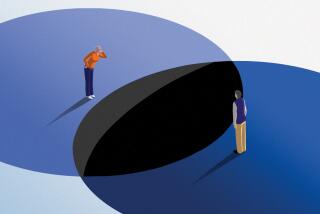True love -- let us calculate the odds
- Share via
TRUE LOVE is like a kick in the head. No, really. It’s not just that it comes out of nowhere, knocks you sideways and changes your life forever. It’s statistically like a kick in the head.
Most statistics are about things that usually happen or that most people share: prices, salaries, IQs, political opinions. These qualities are called “normally distributed”: If you chart them, the graph they produce is that old favorite, the bell curve.
Love, here as everywhere, is different. True love is rare; we can only hope to find it once in a lifetime, and maybe not even then. The curve that charts love is very narrow -- more like a steeple than a bell. It’s called a Poisson curve, and its classic exemplar was the chance of being kicked to death by a horse while serving in the Prussian cavalry.
The normal distribution was discovered during the 18th century, when confident Age of Enlightenment types assumed that all people, places and times were pretty much alike. Statistics that produce a bell curve (like, say, the heights of everyone on your street), show a clear average, with plenty of readings within a predictable range around that average, called a “standard deviation.” Common qualities, such as height, are easy to forecast.
Simeon-Denis Poisson, though, lived in the more unpredictable 19th century. He was interested in rare events. He wanted to discover how well you could predict the chances of one such event occurring during a given time (improbable); two events (very improbable); three (like, totally improbable); or four (so improbable you can forget about it).
Years of work produced a formula that allowed just such prediction -- and Poisson’s successor, Ladislaus Bortkiewicz, applied it to the chances of a given cavalry regiment suffering a death by horse kick in a given year. In a triumph of mathematical prediction, the actual figures for the German army between 1875 and 1894 matched almost perfectly the numbers generated by theory.
While the bell curve describes things we can expect; Poisson’s formula predicts things we fear or hope for -- things that, though rare, could happen at any time. In World War II, the British used it to predict the likelihood of any particular neighborhood in London being hit by a V-2 rocket. Telephone companies use it to predict the likelihood that any particular number is going to ring at a particular moment (it’s low, although somehow much higher when you’re in the bath). The chance that the store will run out of your cat’s favorite food, that you’ll have a fender bender on the way home, the chance a war will break out somewhere today: If there’s an average occurrence of any event over time, however low, Poisson’s formula can predict a likelihood for the here and now.
True love is such an event. It could be today; it could be never. All we know is that it happens to some people, sometimes. This makes me believe that the hope of meeting the love of your life is also governed by the Poisson curve. If so, it suggests some interesting conclusions.
Woody Allen pointed out that being bisexual doubles your chance of a date on Saturday night -- but, sadly, Poisson shows very little change in response even to this drastic rise in probability.
His curve, applied to finding true love, charts two things: the chance this rare event will happen once, twice, thrice, in a lifetime; but also how likely it is to happen at all in progressively more unlikely circumstances. When you move away from the back of the horse, the chance of being kicked to death falls precipitously. Similarly, edging away from the kind of people who are the current focus of your affections (in the hope that, say, a Florentine millionaire-poet-ski champion will come knocking at your door) makes the chance of success drop away much more quickly than it would for normally distributed phenomena.
This implies that your best chances come from seeking out and sustaining friendships with the people you already like most, rather than devoting too much time to the exotic alternatives. Rare things become near-impossible once you compound their rarity -- say, by buying a lottery ticket only on your birthday.
In probability, we have only two ways to control fate: through standards and through opportunities. If you want to avoid a bad Poisson event (like the fender bender), you maintain high standards by driving as defensively as you can. You steer clear of certain routes at certain times to avoid giving the other idiots too many opportunities to hit you. Finding love, too, demands high standards (this is, after all, the person who’ll share your whole existence) but you need lots of opportunities.
Go speed dating, by all means -- remembering that it only selects for a good date, not necessarily a good mate. Get your friends to introduce you to their other friends; you may fit well together. Skew your social life toward those events where you can find out more about potential partners than whether they are just great dancers. Use every experience, good or bad, to refine your vision of that unknown ideal ... so that when the one chance comes, you won’t let it slip. Every step takes you closer to the center of the Poisson curve.
And who am I to tell you this? Someone who knows something about probability; but, more important, the person who went to that dinner party 19 years ago with friends of friends. There across the table was the woman I’d heard about, asked my friends about. Those eyes ... that face ... that character.... Wham!




